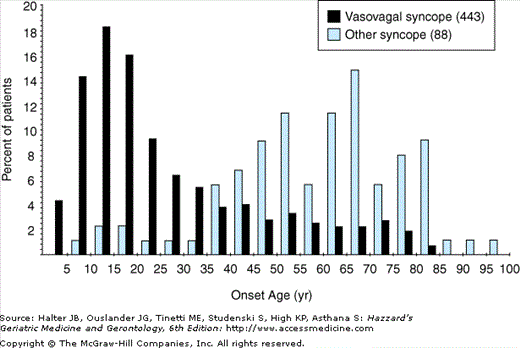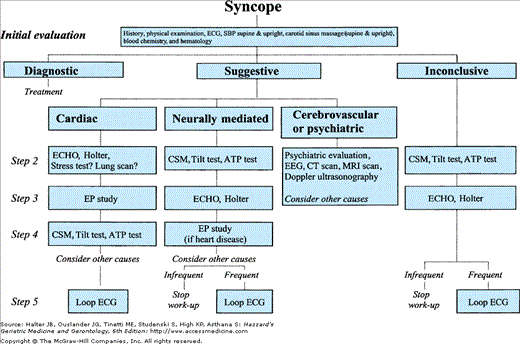Definition
Syncope (derived from the Greek words, “syn” meaning “with” and the verb “koptein” meaning “to cut” or more appropriately in this case “to interrupt”) is a symptom defined as a transient, self-limited loss of consciousness, usually leading to falling. The onset of syncope is relatively rapid, and the subsequent recovery is spontaneous, complete, and usually prompt.
Epidemiology
Syncope is a common symptom, experienced by up to 30% of healthy adults at least once in their lifetime. Syncope accounts for 3% of emergency department visits and 1% of medical admissions to a general hospital. Syncope is the seventh most common reason for emergency admission of patients older than 65 years. The cumulative incidence of syncope in a chronic care facility is close to 23% over a 10-year period with an annual incidence of 6% and recurrence rate of 30%, over 2 years. The age of first faint, a commonly used term for syncope, is less than 25 years in 60% of persons, but 10% to 15% of individuals have their first faint after age 65 years.
Syncope because of a cardiac cause is associated with higher mortality rates than syncope from other causes irrespective of age. In patients with a noncardiac or unknown cause of syncope, older age, a history of congestive cardiac failure, and male sex are important prognostic factors of mortality. It remains undetermined whether syncope is directly associated with mortality or is merely a marker of more severe underlying disease. Figure 57-1 details the age-related difference in prevalence of benign vasovagal syncope (faint) compared to other causes of syncope.
Pathophysiology
The temporary cessation of cerebral function that causes syncope results from transient and sudden reduction of blood flow to parts of the brain (brain stem reticular activating system) responsible for consciousness. The predisposition to vasovagal syncope starts early and lasts for decades. Other causes of syncope are uncommon in young adults, but much more common as people age.
Regardless of the etiology, the underlying mechanism responsible for syncope is a drop in cerebral oxygen delivery below the threshold for consciousness. Cerebral oxygen delivery, in turn, depends on both cerebral blood flow and oxygen content. Any combination of chronic or acute processes that lowers cerebral oxygen delivery below the “consciousness” threshold may cause syncope. Age-related physiological impairments in heart rate, blood pressure, cerebral blood flow, and blood volume control, in combination with comorbid conditions and concurrent medications account for the increased incidence of syncope in the older person. The blunted baroreflex sensitivity with aging is manifested as a reduction in the heart rate response to hypotensive stimuli. Older adults are prone to reduced blood volume owing to excessive salt wasting by the kidneys as a result of a decline in plasma renin and aldosterone, a rise in atrial natriuretic peptide, and concurrent diuretic therapy. Low blood volume together with age-related diastolic dysfunction can lead to a low cardiac output, which increases susceptibility to orthostatic hypotension and vasovagal syncope. Cerebral autoregulation, which maintains a constant cerebral circulation over a wide range of blood pressure changes, is altered in the presence of hypertension and possibly by aging; the latter is still controversial. In general, it is agreed that sudden mild to moderate declines in blood pressure can affect cerebral blood flow markedly and render an older person particularly vulnerable to presyncope and syncope. Syncope may thus result either from a single process that markedly and abruptly decreases cerebral oxygen delivery or from the accumulated effect of multiple processes, each of which contributes to the reduced oxygen delivery.
Up to 40% of patients with recurrent syncope will remain undiagnosed despite extensive investigations, particularly older patients who have marginal cognitive impairment and for whom a witnessed account of events is often unavailable. Although diagnostic investigations are available, the high frequency of unidentified causes in clinical studies may occur because patients failed to recall important diagnostic details, because of the stringent diagnostic criteria used in clinical studies or, probably most often, because the syncopal episode resulted from a combination of chronic and acute factors rather than from a single obvious disease process. Indeed, a multifactorial etiology likely explains the majority of cases of syncope in older persons who are predisposed because of multiple chronic diseases and medication effects superimposed on the age-related physiologic changes described above. Common factors that, in combination, may predispose to or precipitate syncope include anemia, chronic lung disease, congestive heart failure, and dehydration. Medications that may contribute to, or cause, syncope are listed in Table 57-1.
DRUG | MECHANISM |
|---|---|
Diuretics | Volume depletion |
Vasodilators Angiotensin-converting enzyme inhibitors Calcium channel-blockers Hydralazine Nitrates Alpha adrenergic blockers Prazosin | Reduction in systemic vascular resistance and venodilation |
Other antihypertensive drugs Alpha methyldopa Clonidine Guanethidine Hexamethonium Labetalol Mecamylamine Phenoxybenzamine | Centrally acting antihypertensives |
Drugs associated with torsades de pointes Amiodarone Disopyramide Encainide Flecainide Quinidine Procainamide Sotalol | Ventricular tachycardia associated with a prolonged QT interval |
Digoxin | Cardiac arrhythmias |
Psychoactive drugs Tricyclic antidepressants Phenothiazines Monoamine oxidase inhibitors Barbiturates | Central nervous effects causing hypotension; cardiac arrhythmias |
Alcohol | Central nervous system effects causing hypotension; cardiac arrhythmias |
Common causes of syncope are listed in Table 57-2. The most frequent individual causes of syncope in older patients are neurally mediated syndromes including carotid sinus syndrome, orthostatic hypotension, and postprandial hypotension as well as arrhythmias including both tachyarrhythmias and bradyarrhythmias. These disease processes are described in the next section. Disorders that may be confused with syncope and that may, or may not, be associated with loss of consciousness are listed in Table 57-3.
Reflex Syncopal Syndromes |
|
Orthostatic
|
Cardiac Arrhythmias
|
Structural Cardiac or Cardiopulmonary Disease
|
Cerebrovascular
|
Multifactorial |
Transient ischemic attacks (TIA) of carotid or vertebrobasilar origin |
Hypoglycemia and other metabolic disorders |
Some forms of epilepsy |
Alcohol and other intoxications |
Hyperventilation with hypocapnia |
Presentation
The underlying mechanism of syncope is transient cerebral hypoperfusion. In some forms of syncope, there may be a premonitory period in which various symptoms (e.g., light-headedness, nausea, sweating, weakness, and visual disturbances) offer warning of an impending syncopal event. Often, however, loss of consciousness occurs without warning. Recovery from syncope is usually accompanied by almost immediate restoration of appropriate behavior and orientation. Amnesia for loss of consciousness occurs in many older individuals and in those with cognitive impairment. The postrecovery period may be associated with fatigue of varying duration.
Syncope and falls are often considered two separate entities with different etiologies. Recent evidence suggests, however, that these conditions may not always distinctly be separate. In older adults, determining whether patients who have fallen have had a syncopal event can be difficult. Half of syncopal episodes are unwitnessed and older patients may have amnesia for loss of consciousness. Amnesia for loss of consciousness has been observed in half of patients with carotid sinus syndrome who present with falls and a quarter of all patients with carotid sinus syndrome irrespective of presentation. More recent reports confirm a high incidence of falls in addition to traditional syncopal symptoms in older patients with sick sinus syndrome and atrioventricular conduction disorders. Thus, syncope and falls may be indistinguishable and may, in some cases, be manifestations of similar pathophysiologic processes. The presentation of specific causes of syncope is presented in the following sections.
Evaluation
The initial step in the evaluation of syncope is considering whether there is a specific cardiac or neurologic etiology or whether the etiology is likely multifactorial. The starting point for the evaluation of syncope is a careful history and physical examination. A witness account of events is important to ascertain when possible. Three key questions should be addressed during the initial evaluation: (1) Is loss of consciousness attributable to syncope? (2) Is heart disease present or absent? (3) Are there important clinical features in the history and physical examination, which suggest the etiology?
Differentiating true syncope from other ‘nonsyncopal’ conditions associated with real or apparent loss of consciousness is generally the first diagnostic challenge and influences the subsequent diagnostic strategy (Table 57-3). A strategy for differentiating true and nonsyncope is outlined in Figures 57-2 and 57-3. The presence of heart disease is an independent predictor of a cardiac cause of syncope, with a sensitivity of 95% and a specificity of 45%.
Patients frequently complain of dizziness alone or as a prodrome to syncope and unexplained falls. Four categories of dizzy symptoms—vertigo, dysequilibrium, light-headedness, and others—have been recognized (see Chapter 56). The categories have neither the sensitivity nor specificity in older, as in younger, patients. Dizziness, however, may more likely be attributable to a cardiovascular diagnosis if associated with pallor, syncope, prolonged standing, palpitations, or the need to lie down or sit down when symptoms occur.
Initial evaluation may lead to a diagnosis based on symptoms, signs, or ECG findings. Under such circumstances, no further evaluation is needed and treatment, if any, can be planned. More commonly, the initial evaluation leads to a suspected diagnosis (Figure 57-3), which needs to be confirmed by directed testing. If a diagnosis is confirmed by specific testing, treatment may be initiated. On the other hand, if the diagnosis is not confirmed, then patients are considered to have unexplained syncope and should be evaluated following a strategy such as that outlined in Figure 57-2. It is important to attribute a diagnosis, if possible, rather than assume that an abnormality known to produce syncope or hypotensive symptoms is the cause. In order to attribute a diagnosis, patients should have symptom reproduction during investigation and preferably alleviation of symptoms with specific intervention. It is common for more than one predisposing disorder to coexist in older patients, rendering a precise diagnosis difficult. In older persons, treatment of possible causes without clear verification of attributable diagnosis may often be the only option.
An important issue in patients with unexplained syncope is the presence of structural heart disease or an abnormal ECG. These findings are associated with a higher risk of arrhythmias and a higher mortality at 1 year. In these patients, cardiac evaluation consisting of echocardiography, stress testing, and tests for arrhythmia detection such as prolonged electrocardiographic and loop monitoring or electrophysiological study is recommended. The most alarming ECG sign in a patient with syncope is probably alternating complete left and right bundle branch block, or alternating right bundle branch block with left anterior or posterior fascicular block, suggesting trifascicular conduction system disease and intermittent or impending high-degree AV block. Patients with bifascicular block (right bundle branch block plus left anterior or left posterior fascicular block, or left bundle branch block) are at high risk of developing high-degree AV block. A significant problem in the evaluation of syncope and bifascicular block is the transient nature of high-degree AV block and, therefore, the long periods required to document it by ECG.
In patients without structural heart disease and a normal ECG, evaluation for neurally mediated syncope should be considered. The tests for neurally mediated syncope consist of tilt testing and carotid sinus massage.
The majority of older patients with syncope are likely to have a multifactorial etiology and thus both predisposing and precipitating causes should be sought in the history, examination, and laboratory evaluation (Tables 57-1 and 57-2), particularly if the initial evaluation does not suggest an obvious single cause.












